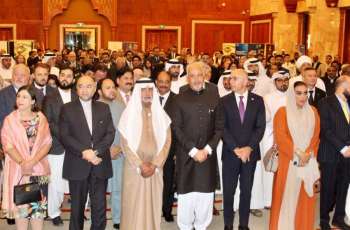MOSCOW (Pakistan Point News / Sputnik - 04th November, 2020) Russia is celebrating National Unity Day on Wednesday.
National Unity Day was established in accordance with an amendment to Article 1 of the Federal Law on Days of Military Glory (Victory Days) of Russia, dated December 29, 2004.
The new public holiday, approved at the initiative of the Interfaith Council of Russia, was first celebrated on November 4, 2005.
National Unity Day is meant to commemorate the events of 1612, when Kuzma Minin and Dmitry Pozharsky led a volunteer army to liberate Moscow from Polish occupation. Historically, it marked the end of the Time of Troubles in Russian history.
The Time of Troubles began with the death of Ivan the Terrible in 1584 and continued until the establishment of the Romanov Dynasty in 1613. A period of a deep crisis caused by the end of the Rurik dynasty, or the Rurikids, soon developed into a national and state crisis compounded by the collapse of the united Russian state and the appearance of numerous pretenders to the throne, as well as widespread disorder.
Power in Moscow was usurped by the Seven Boyars (nobles) led by Prince Fyodor Mstislavsky, who opened the Kremlin gates to Polish troops, hoping to bring Prince Wladyslaw, a Catholic, to the Russian throne.
Patriarch Hermogenes called on Russians to defend the Orthodox Church and drive the Polish invaders out of Moscow.
"It's time to give your lives to the House of the Most Holy Mother of God," the patriarch wrote.
The people responded willingly, joining volunteer units to fight the invaders. The first popular movement was headed by Prokopy Lyapunov, a military governor from Ryazan. The movement dispersed after the governor was killed by Cossacks and a discord between the latter and noblemen further deepened. The anti-Polish rebellion, which began in Moscow on March 19, 1611, was quelled.
In September 1611, Kuzma Minin, a meat trader and a district head in Nizhny Novgorod, appealed to people to join the volunteer troops.
Responding to Minin's appeal, people of Nizhny Novgorod provided one-third of their property for the maintenance of the local volunteer corps. But this was not enough, and soon another appeal was made, this time for an additional one-fifth of their property.
Kuzma Minin donated all of his money to the army, and his wife is said to have given her jewelry.
Acting on Minin's plea, people appealed to Novgorod Prince Dmitry Pozharsky, then 30 years old, to take helm of the volunteer troops. The prince agreed to become their military leader on condition that Nizhny Novgorod residents choose a trusted aide to oversee the public funds. People chose Minin, which is why the volunteer corps had two leaders, both chosen and trusted by the people.
Minin and Pozharsky rallied a large army of over 10,000 service-class people (bound by obligations of service, especially military service to the Moscow State), about 3,000 Cossacks, over 1,000 Streltsy (riflemen) and many peasants bound by military service obligations.
People from all classes of Russian society and all ethnic groups in the Russian state joined together to liberate their homeland from the invaders.
The Nizhny Novgorod voluntary corps, marching under an icon of Our Lady of Kazan, uncovered in Kazan in 1579, stormed Kitay Gorod (the external walls of Moscow) on November 4, 1612, driving the invaders out of Moscow. That victory provided powerful impetus for the revival of the Russian state. The icon of Our Lady of Kazan became the protector of all Russia.
The liberation of Moscow created conditions for the restoration of state power and the election of a new tsar. In November 1612, the leaders of the volunteer corps sent invitations to all Russian cities to attend a national assembly (the Zemsky Sobor). In late February 1613, the Zemsky Sobor, comprising representatives of all classes of Russian society (clergy, boyars, noblemen, Cossacks, peasants, etc.), elected Mikhail Romanov, the son of Metropolitan Filaret, as the new tsar, the first of the Romanov Dynasty.
The 1613 Zemsky Sobor ended the Time of Troubles and marked the victory of Orthodoxy and national unity.
According to the Nikon Chronicle, a compilation of chronicles for the time, after driving the Polish invaders out of Moscow, Prince Dmitry Pozharsky placed the icon of Our Lady of Kazan in his parish church of the Presentation of the Virgin in the Temple in the Lubyanka district in Moscow.
Later, the Cathedral of Our Lady of Kazan was built on Red Square on Pozharsky's donations. The now widely accepted miracle-working icon, which Pozharsky had brought to Moscow for the battle against the invaders, was moved to the new church in 1636 and remained there for the next 300 years. The icon was later moved to the Epiphany Cathedral at Yelokhovo in Moscow.
Tsar Alexei Mikhailovich, who ruled from 1645-1676, established a holiday to commemorate the liberation of Moscow, the Day of the Icon of Our Lady of Kazan. It was celebrated as an Orthodox and state holiday until 1917. The day is now celebrated on November 4 (October 22 Old Style) as an Orthodox Holiday of Day of the Icon of Our Lady of Kazan, in memory of the 1612 liberation of Moscow.
National Unity Day is thus not a new holiday but an old tradition that has recently been revived.
On National Unity Day, political parties and public movements around Russia hold demonstrations, marches, concerts, as well as educational, charity and sports events.



